It’s no secret that lower back pain is one of the most common problems that weightlifters have to deal with on a regular basis.
Many athletes spend hours each week training their lower backs—using Deadlifts, Supermans, Back Hyperextensions, Good Mornings, and countless other exercises—to try and strengthen the muscles that support the spine.
Why? Because the spine does so much of the work in your weight lifting!
Think about it:
- When you do an Overhead Shoulder Press, your spinal muscles have to keep your upper body straight while you push up.
- When you Lunge, your spinal muscles have to work to keep your upper body straight while your lower body moves forward.
Your lower back muscles are utilized in so many of the upper and lower body movements, so it’s no surprise that they can get strained, stressed, or even injured.
Athletes concerned for their lower back health can always train the muscles harder to try and strengthen them. But there’s another way to go: find alternative exercises that reduce lower back strain and improve focus on the specific muscles being targeted.
Level Up Your Fitness: Join our 💪 strong community in Fitness Volt Newsletter. Get daily inspiration, expert-backed workouts, nutrition tips, the latest in strength sports, and the support you need to reach your goals. Subscribe for free!
For your lower body, the Belt Squat is one of the single best exercises you can do to maximize leg muscle recruitment while reducing lower back strain. Below, we’re going to take a deep dive into why the Belt Squat is highly effective for building serious leg strength while also protecting your back from strain or injury!
What is the Belt Squat?
The Belt Squat is an exercise that uses a standard squat movement, but rather than loading all the weight up on your shoulders, it puts the load on your hips and lower body via a belt that you wear around your waist.
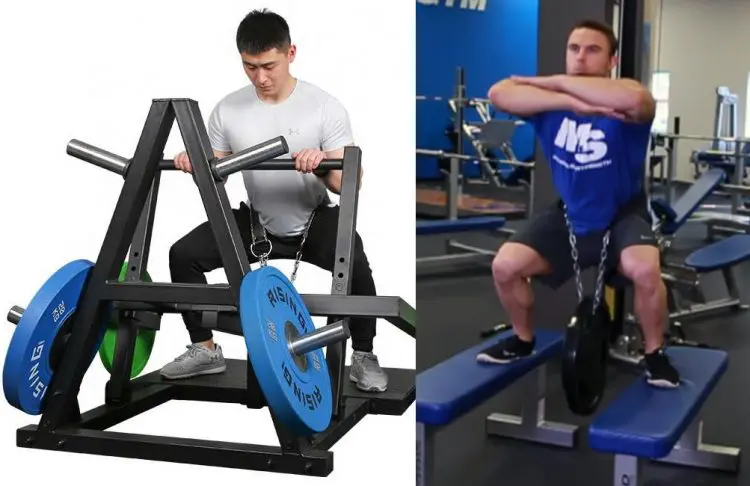
There are two options for performing Belt Squats:
- Belt Squat Machine – This is typically a cable machine that is designed specifically for Belt Squats. The trainee stands on a flat platform and secures a belt around their waist. There is a cable connecting the belt to the weights. As the trainee squats, the weight increases, forcing them to push to stand back up.
- Dip Belt – A Dip Belt is typically used to perform Weighted Dips. It is a sturdy belt with a chain that can be connected to a weight between the legs. Belt Squats using this dip belt can be performed either by wrapping the chain around a landmine barbell, or by using an elevated platform (like a raised dip bar) to stand on with the weight disc dangling between the legs.
The exercise is as simple as a standard squat, with the exact same posture and form. The only difference is the placement of the load—on the hips rather than the shoulders. As you’ll see, that makes a huge difference to your lower back!
Belt Squat vs. Front/Back Squat
Everyone is familiar with the two most popular squat variations: the Front Squat and Back Squat.
The Front Squat involves gripping the barbell across the front of your shoulders, while the Back Squat involves resting the weight on the back of your shoulders or on your upper back. This allows you to carry a lot of weight, but it also increases the strain on your spine.
With a Belt Squat, however, the weight is all resting on your hips and waist. Because the load is placed BELOW your lower back, your spinal muscles are barely engaged—only enough to keep your upper body stable and maintain your balance in the squat. The result is a movement that is exponentially easier on your lower back, but still delivers an excellent lower body workout.
This has some serious benefits:
Faster recovery
When you’re squatting with the weight loaded on your shoulders, your entire core is recruited along with your lower body. This means that you’ll use more muscles, burn more energy, and thereby require a longer recovery time.
With the weight concentrated entirely on your legs, only your leg muscles are used, leading to less energy burned overall. Recovery time between sets is faster because your blood flow is concentrated on the single muscle group being used.
Reduced risk of injury
Just by shifting the weight from your upper body to your lower body drastically decreases the risk of injury. A study found that “belt squats may provide a similar or greater external loading for the musculoskeletal system of the lower extremities while reducing external spinal loading.”
In another study, the authors concluded, “belt squatting provides similar muscular demands for the quadriceps, hamstrings, and plantar flexors, but is less demanding of trunk stabilizers, and gluteal muscles. Belt squats may be a suitable alternative to back squats in order to avoid stressing low back or trunk musculature.”
You’ll be able to add heavier weights and train to failure knowing that you won’t harm your back!
Better focus
One study found that gluteal muscle activation decreased during belt squats, meaning more concentration on the quadriceps muscles. In one of the above-mentioned studies, “Belt squatting did not alter activation of the lower extremities except for a decrease in the gluteus maximus (35.2% impulse and 32.1% peak), gluteus medius (54.1% impulse and 55.2% peak). Furthermore, belt squatting reduced activation of the rectus abdominus (44.3% impulse; 31.1% peak), and external obliques (45.8% impulse; 53.7% peak) as compared to back squatting.”
Level Up Your Fitness: Join our 💪 strong community in Fitness Volt Newsletter. Get daily inspiration, expert-backed workouts, nutrition tips, the latest in strength sports, and the support you need to reach your goals. Subscribe for free!
Shifting the focus away from your lower back and glutes means that all the work is being done by your leg muscles. And that focus is exactly what you want for targeted, effective strength gains!
Better for injured upper bodies
If you’re dealing with an upper body injury—such as a shoulder sprain or a neck strain—supporting a heavy barbell for either a Front or Back Squat can cause pain. For those with lower back pain or recovering from a slipped disc or other back injury, standard weighted squats are contraindicated because of the weight placed on your lower back.
With Belt Squats, however, there is no weight on your upper body or your back. The belt shifts the weight downward to your hips and waist. This change in load placement can drastically reduce the risk of back strain, and will still allow those with injured backs or upper bodies to squat.
Traction-like effect
Spinal traction relieves pressure on your spine using decompression. It’s a popular sports therapy for spinal injuries or damage. With a belt sitting on your hips, it can actually feel a bit like you’re getting spinal traction. The belt actually pulls downward on your spine, delivering a traction-like effect that can elongate your spine and improve your range of mobility.
Is Belt Squat better than Leg Press?
The Leg Press (using a machine) is another alternative for reducing pressure on your lower back while working your legs safely. Just like squats, Leg Presses target the quadriceps muscles, but also work your hamstrings and quads. The fact that you’re sitting or lying on a padded backrest means that you have a solid platform to push against without the need to engage your lower back muscles while your legs are working.
The Leg Press is definitely a good Squat alternative for those with lower back injuries. Adjusting your foot position helps you shift the weight to focus on different leg muscles, and adjust how it feels on your back. The lower range of motion concentrates the work on your quads, reducing emphasis on your glutes and hamstrings compared to squats.
However, it requires a Leg Press Machine, which is far less common than a barbell with free weights or a Squat Rack. There is also a higher risk of leg injury if you lock your knees or round your back to press heavy. People often end up trying to press more than they are capable of, which can increase the chance of strain or injury.
Belt Squats, on the other hand, do engage the glutes and hamstrings more, making them a more complete leg workout rather than targeting the quads. This can actually be a good thing, though, as it means you’re developing well-rounded, functional strength. You will move more easily and fluidly when training for a natural motion (squatting) compared to a limited movement like leg pressing. Squats also improve knee flexibility and force you to engage your core to remain balanced, but with the weight on your waist and hips, there is minimal risk of lower back strain.
How much weight should I use on a belt squat?
The answer to this question is simple: as much as you feel comfortable with, and a weight that pushes your muscles to fatigue!
You may already know your 1-Rep Max weight for a Front Squat or Back Squat using a barbell in the standard position. However, be warned: the weight won’t necessarily be the same with Belt Squats, at least not right off the bat. Your hips and waist may feel discomfort if you load them up with max weight. It’s worth doing a few lighter sets to experiment with weight to find out what feels right for your lower body using this new exercise.
Drop the weight to 50% of your Front or Back Squat 1-Rep Max. That should be more than light enough for your hips and waist to support the weight without discomfort. Perform a couple of sets at this very light weight to get a feel for the exercise.
(Note: There will be a difference depending on whether you use the Belt Squat machine or use a Dip Belt secured to weight discs or a landmine bar. That’s why it’s recommended that you do a few test sets to get a feel for the new load placement.)
The fact that it’s only your legs doing the work may actually mean you’re not capable of lifting as much weight as you expected. With Front and Back Squats, your lower back and core muscles end up doing some of the work of coming up from the squat position and lifting the weight (hence the higher injury risk).
So start off at a light 50% weight, and after performing a couple of test sets, increase it to 60%. You should feel a solid difference between these two weights. Try increasing the weight until you find what feels comfortable for the first few days training with this exercise. You can also set a new 1-Rep Max using this new movement to make sure you’ve got the right weights to work with.
Belt Squat Exercises to Try
The beauty of Belt Squats is that you can do a lot of the Squat variations, just using the belt. Some of the best for training with the belt include:
- Sumo Belt Squats
- Staggered Belt Squats
- Split Belt Squat
- Belt Squat Marches
These are all compatible with both cable machines and landmine bars, so they make a great option to enhance your lower body training!
Conclusion
Belt Squats are an excellent alternative for those who want to shred their legs without straining their lower backs—or are recovering from an injury. Shifting the weight off the shoulders and down onto the hips/waist will reduce lower back strain and increase leg muscle engagement.
If you’re looking for a safer, smarter way to train your lower body, Belt Squats may just be the right way for you to go! Just be sure to start with less weight and get a feel for the movement before loading the belt up to the max. Your hips will need time to adjust to the shifted load, and you may need to improve your balance before you start squatting a full volume.
Interested in measuring your progress? Check out our strength standards for Good Morning, Shoulder Press, Deadlift, and more.

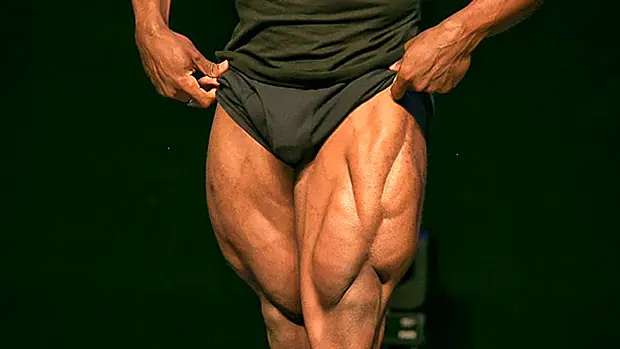

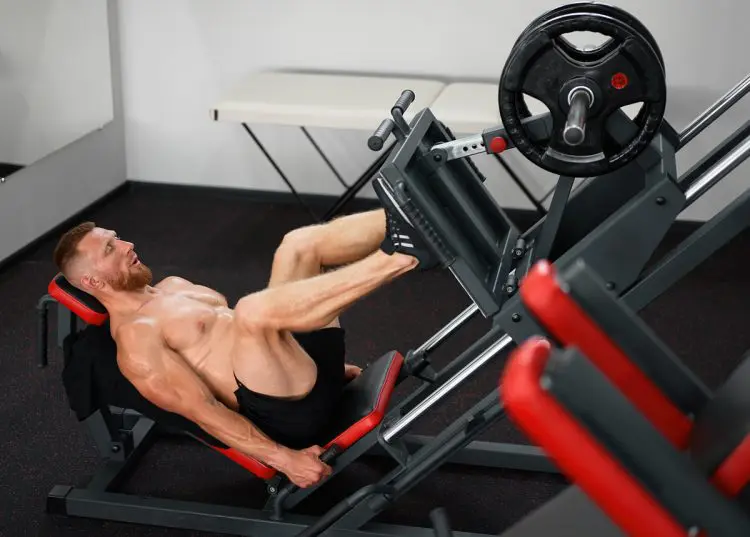

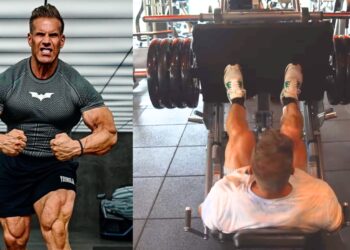


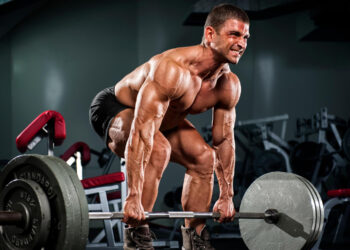

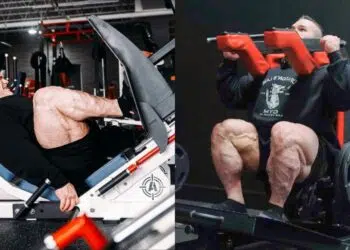

Thank you for this great article. I just purchased a belt squat machine for my home. And I’m absolutely hooked. The issue is that I recently noticed that my left oblique muscle down near my hip is extremely sore. Perhaps I’ve gone too heavy too soon?? I did double up for 2x week since it’s so much fun. Any advice on this? The belt feels comfortable when I wear it.